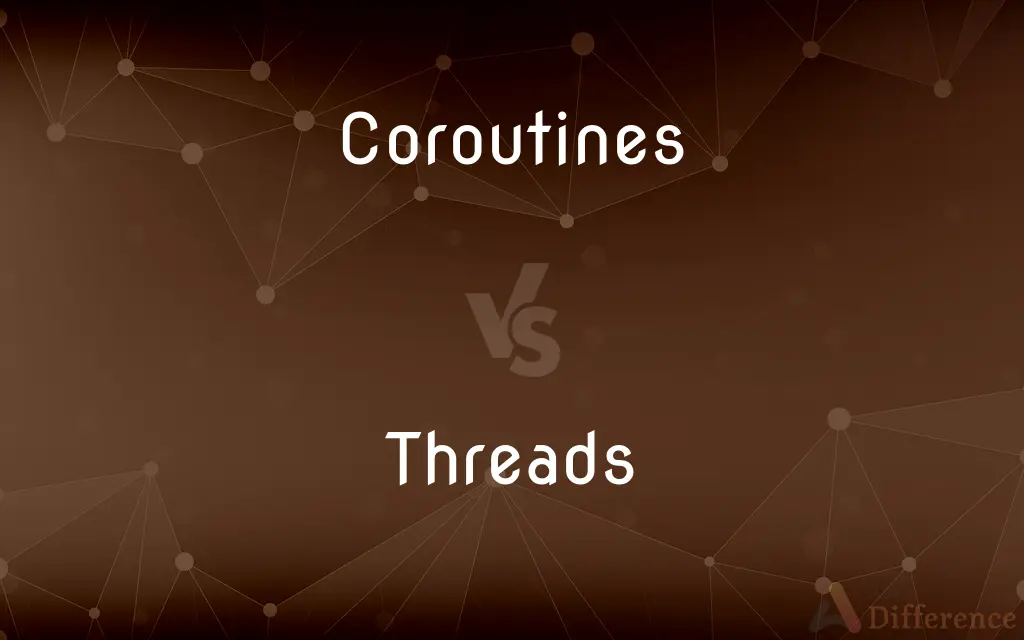Coroutines vs. Threads — What's the Difference?
By Tayyaba Rehman — Published on January 11, 2024
Coroutines are lightweight control structures allowing concurrent execution within single thread, focusing on cooperative multitasking. Threads are OS-managed paths of execution, can run concurrently on multiple CPUs, focusing on pre-emptive multitasking.

Difference Between Coroutines and Threads
Table of Contents
ADVERTISEMENT
Key Differences
Coroutines are programming components that generalize subroutines for non-preemptive multitasking. They allow multiple entry points for suspending and resuming execution at certain locations. Contrarily, Threads are a feature of the operating system that can run in parallel, especially on multi-core processors, providing true concurrent execution.
Coroutines manage their own state and control flow, and they 'cooperate' to switch execution among themselves without preemption. This means they decide when to give up control. Threads, however, are preemptively multitasked by the operating system, meaning the OS decides when to switch context between threads, often without input from the threads themselves.
In terms of resource usage, Coroutines are more lightweight than threads. They use less memory and resources because they don't require their own stack memory like threads. This makes Coroutines efficient for tasks that maintain a lot of state or are involved in I/O-bound operations. Threads, being managed by the OS, consume more resources and have a higher overhead due to context switching.
Coroutines fit well in scenarios where tasks need to be done cooperatively, such as asynchronous I/O operations, whereas Threads are suitable for CPU-bound tasks that benefit from parallel execution. This difference makes coroutines a popular choice in single-threaded environments like JavaScript or Python’s asyncio.
Error handling in Coroutines is typically more straightforward than in threads because control flow is more predictable. In contrast, Threads can be more complex to manage due to potential issues like race conditions and deadlocks.
ADVERTISEMENT
Comparison Chart
Multitasking Type
Cooperative multitasking
Preemptive multitasking
Resource Usage
Lightweight, less memory
Heavier, more memory per thread
Parallel Execution
Concurrent execution within a single thread
True parallel execution on multi-core CPUs
Typical Use
Asynchronous tasks, I/O operations
CPU-intensive tasks
Complexity
Easier error handling and control flow
More complex, prone to synchronization issues
Compare with Definitions
Coroutines
Allow suspending and resuming execution at certain points.
Coroutines in Python manage async I/O without blocking the main thread.
Threads
Paths of execution managed by the operating system.
Threads in our application run parallel calculations on a multi-core processor.
Coroutines
Utilize cooperative multitasking.
Coroutines voluntarily yield control to run multiple routines in a single thread.
Threads
Support true parallel execution.
Using multiple threads leverages the multicore architecture of modern CPUs.
Coroutines
Lightweight compared to threads.
Using coroutines reduces overhead in our server application.
Threads
Fine cord of a fibrous material, such as cotton or flax, made of two or more filaments twisted together and used in needlework and the weaving of cloth.
Coroutines
Suitable for asynchronous programming.
We implemented coroutines for handling concurrent network requests.
Threads
A piece of such cord.
Coroutines
Execute concurrently within a single thread.
Coroutines in JavaScript allow for non-blocking code execution.
Threads
A thin strand, cord, or filament of natural or manufactured material.
Threads
Something that suggests the fineness or thinness of such a strand, cord, or filament
A thread of smoke.
Threads
Something that suggests the continuousness of such a strand, cord, or filament
Lost the thread of his argument.
Threads
A helical or spiral ridge on a screw, nut, or bolt.
Threads
A portion of a program that can run independently of and concurrently with other portions of the program.
Threads
A set of posts on a newsgroup, composed of an initial post about a topic and all responses to it.
Threads
Threads(Slang)Clothes.
Threads
To pass one end of a thread through the eye of (a needle, for example).
Threads
To pass (something) through in the manner of a thread
Thread the wire through the opening.
Threads
To pass a tape or film into or through (a device)
Thread a film projector.
Threads
To pass (a tape or film) into or through a device.
Threads
To connect by running a thread through; string
Thread beads.
Threads
(Sports) To throw or send (a pass) through a heavily defended area to a teammate.
Threads
To make one's way cautiously through
Threading dark alleys.
Threads
To make (one's way) cautiously through something.
Threads
To occur here and there throughout; pervade
“More than 90 geologic faults thread the Los Angeles area” (Science News).
Threads
To machine a thread on (a screw, nut, or bolt).
Threads
To remove (body hair) by using a looped thread that has been wound tightly in the middle.
Threads
To make one's way cautiously
Threaded through the shoals and sandbars.
Threads
To proceed by a winding course.
Threads
To form a thread when dropped from a spoon, as boiling sugar syrup.
Threads
Plural of thread
Threads
(slang) Clothes.
Threads
Clothes; clothing; as, he was wearing his new threads at the party.
Threads
Informal terms for clothing
Threads
Involve pre-emptive multitasking.
The OS preemptively manages the execution time of each thread.
Threads
More resource-intensive than coroutines.
Each thread in our system consumes its own stack space.
Threads
Prone to synchronization issues.
Thread management requires careful handling to avoid deadlocks.
Common Curiosities
What are Coroutines?
Programming constructs that allow suspending and resuming execution for cooperative multitasking.
Can a single-threaded application use Threads?
It can, but threads won’t run in parallel without a multi-core processor.
Are Coroutines part of the programming language or OS?
They are typically part of a programming language's functionality.
Can Coroutines improve application performance?
Yes, especially in I/O-bound tasks or when managing lots of state.
Do Threads consume more memory than Coroutines?
Yes, threads are more resource-intensive due to requiring their own stack space.
How do Coroutines handle multitasking?
Through cooperative multitasking, where they voluntarily yield control.
Do Threads offer more concurrency than Coroutines?
Yes, especially on systems with multiple processors or cores.
How do Threads and Coroutines differ in error handling?
Error handling is often simpler in coroutines due to more predictable control flow.
Is it easier to write asynchronous code with Coroutines?
Yes, coroutines simplify writing asynchronous code.
When should I use Coroutines?
For tasks involving asynchronous operations or when working with single-threaded environments.
Are Coroutines suitable for CPU-intensive tasks?
Generally, no. Threads are better suited for CPU-bound parallel processing.
What are Threads?
Operating system-managed paths of execution that can run concurrently, often on multiple processors.
Can Coroutines run in parallel?
They run concurrently within a single thread but not in parallel across multiple CPUs.
Why are Threads prone to synchronization issues?
Due to the complexity of managing shared resources in a parallel execution environment.
Are Coroutines supported in all programming languages?
No, they are language-specific and not available in every programming language.
Share Your Discovery

Previous Comparison
Fact Table vs. Dimension Table
Next Comparison
Crystal Malt vs. Caramel MaltAuthor Spotlight
Written by
Tayyaba RehmanTayyaba Rehman is a distinguished writer, currently serving as a primary contributor to askdifference.com. As a researcher in semantics and etymology, Tayyaba's passion for the complexity of languages and their distinctions has found a perfect home on the platform. Tayyaba delves into the intricacies of language, distinguishing between commonly confused words and phrases, thereby providing clarity for readers worldwide.












































